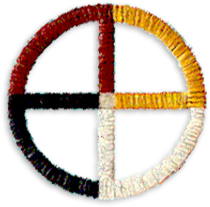Home » Native American Culture » Beliefs and Traditions » The Medicine Wheel
The Medicine Wheel

Donate Now to help preserve the Lakota culture!
To the untrained eye, the Medicine Wheel might seem like a simple circle. For the Great Sioux Nation, the Medicine Wheel holds a much deeper meaning. Yes, its shape is that of a circle; however, the accompanying lines, the feather and the wheel’s Four Directions combine to mean so much more.
The Medicine Wheel is a sacred symbol used by the indigenous Plains tribes to represent all knowledge of the universe. The Medicine Wheel is a symbol of hope — a movement toward healing for those who seek it.
The Circle
The circle of the Medicine Wheel represents the sacred outer boundary of the Earth, often called the Sun Dance Circle or the Sacred Hoop. Its circular shape represents the continuous pattern of life and death, the path of the sun and moon, the shape of a family home (the tipi), the shape of the drum, and other significant pieces of Lakota culture. The circle plays a role in many Native American beliefs and traditions.
The Lines
Both the horizontal and vertical lines represent the sun’s and man’s sacred paths. The crossing of the two lines in the middle of the circle indicates the center of the Earth.
The Feather
When included in the Medicine Wheel, the eagle feather is a sign of Wakȟáŋ Tȟáŋka’s — the Great Spirit’s — power over all. Typically, when someone is presented with a Medicine Wheel with an attached eagle feather, it is to signify a great accomplishment, such as a graduation ceremony or another momentous life event.
The Four Directions
According to “Native Voices” as a part of the National Library of Medicine, different tribes interpret the Medicine Wheel differently in terms of direction and color association. Each of the Four Directions (west, north, east and south) are typically represented by a distinctive color, usually black, red, yellow, and white.
St. Joseph’s Native American Studies curriculum follows the outline that North is red, East is yellow, South is white and West is Black.
The Four Directions can also represent the four seasons of spring, summer, fall and winter; the four elements of water, air, earth and fire; the four life stages of birth, childhood, adulthood and elder; and so on.
Adapted from Black Elk Speaks by John G. Neidhardt
